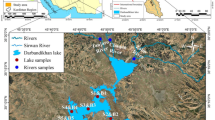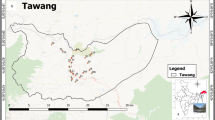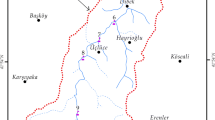Abstract
In this study, observations were carried out in the surface waters of Saraydüzü Dam Lake within Sinop provincial borders for 1 year to determine water quality. The basic 28 variables used to determine water quality were measured monthly at six stations. Taking into account the World Health Organization's drinking water standards, the water quality index (WQI) and Turkey’s Ministry of Forestry and Water Affairs Surface Water Quality Regulations (SWQR) were used in determining the water quality. In addition, irrigation water quality was examined. For this, sodium absorption rates (SAR), sodium percentage and residual sodium carbonate (RSC) values were calculated. WQI values in the lake were found to be between 17.62 and 29.88. Water quality parameters did not exceed the recommended limit values in all months and at all stations. According to these values, the Saraydüzü Dam Lake water belongs to the ‘very good’ class in terms of drinking water quality. The results obtained showed that there were no nitrogen or phosphate inputs that could harm the ecosystem in the lake and that there were no low/insufficient ambient oxygen conditions resulting from excessive oxygen consumption during the degradation process of organic matter. All water quality parametres are well below the permissible limits except some heavy metals according to SWQR. Cu, Zn and Fe were found to exceed the limit values. The water quality of irrigation water was found to be good in terms of SAR and sodium percentage, whereas RSC was observed to have varying qualities during the year and not be suitable for irrigation in some months. According to results of factor analysis (FA), pH, temperature, electrical conductivity, suspended solid matter (SSM), biological oxygen demand (BOD), total hardness (TH),total alkalinity (TA), calcium, nitrate, ammonium, mercury and dissolved oxygen are the main variables responsible for the processes in the ecosystem.




Similar content being viewed by others
References
Ali, E. M., & Khairy, H. M. (2016). Environmental assessment of drainage water impacts on water quality and eutrophication level of Lake Idku, Egypt. Environmental Pollution, 216, 437–449. https://doi.org/10.1016/j.envpol.2016.05.064.
APHA. (1998). Standart methods for the ezamination of water and wastewater (20th ed.). Washington DC: American Public Health Association.
Bai, J., Cui, B., Chen, B., Zhang, K., Deng, W., Gao, H., & Xiao, R. (2011). Spatial distribution and ecological risk assessment of heavy metals in surface sediments from a typical plateau lake wetland, China. Ecological Modelling, 222(2), 301–306. https://doi.org/10.1016/j.ecolmodel.2009.12.002.
Belal, A. A. M., El-Sawy, M. A., & Dar, M. A. (2016). The effect of water quality on the distribution of macro-benthic fauna in Western Lagoon and Timsah Lake, Egypt.I. The Egyptian Journal of Aquatic Research, 42(4), 437–448. https://doi.org/10.1016/j.ejar.2016.12.003.
Bing, H., Wu, Y., Nahm, W.-H., & Liu, E. (2013). Accumulation of heavy metals in the lacustrine sediment of Longgan Lake, middle reaches of Yangtze River, China. Environmental Earth Sciences, 69(8), 2679–2689. https://doi.org/10.1007/s12665-012-2090-4.
Boyacioglu, H., & Boyacioglu, H. (2008). Water pollution sources assessment by multivariate statistical methods in the Tahtali Basin, Turkey. Environmental Geology, 54(2), 275–282. https://doi.org/10.1007/s00254-007-0815-6.
Çevik, F., Göksu, M. Z. L., Derici, O. B., & Fındık, Ö. (2009). An assessment of metal pollution in surface sediments of Seyhan dam by using enrichment factor, geoaccumulation index and statistical analyses. Environmental Monitoring and Assessment, 152(1–4), 309–317. https://doi.org/10.1007/s10661-008-0317-3.
Dalakoti, H., Mishra, S., Chaudhary, M., & Singal, S. K. (2017). Appraisal of water quality in the lakes of Nainital District through numerical indices and multivariate statistics, India. International Journal of River Basin Management, 16, 1–11. https://doi.org/10.1080/15715124.2017.1394316.
Das Kangabam, R., & Govindaraju, M. (2017). Anthropogenic activity-induced water quality degradation in the Loktak lake, a Ramsar site in the Indo-Burma biodiversity hotspot. Environmental Technology, 1–10. https://doi.org/10.1080/09593330.2017.1378267.
Faragallah, H. M., Askar, A. I., Okbah, M. A., & Moustafa, H. M. (2009). Physico-chemical characteristics of the open Mediterranean sea water far about 60 km from Damietta harbor, Egypt. Journal of Ecology and The Natural Environment, 1(5), 106–119.
Gao, H., Bai, J., Xiao, R., Liu, P., Jiang, W., & Wang, J. (2013). Levels, sources and risk assessment of trace elements in wetland soils of a typical shallow freshwater lake, China. Stochastic Environmental Research and Risk Assessment, 27(1), 275–284. https://doi.org/10.1007/s00477-012-0587-8.
He, B., Oki, K., Wang, Y., Oki, T., Yamashiki, Y., Takara, K., Miura, S., Imai, A., Komatsu, K., & Kawasaki, N. (2012). Analysis of stream water quality and estimation of nutrient load with the aid of quick bird remote sensing imagery. Hydrological Sciences Journal, 57(5), 850–860. https://doi.org/10.1080/02626667.2012.683792.
Horppila, J., Holmroos, H., Niemistö, J., Massa, I., Nygrén, N., Schönach, P., Tapio, P., & Tammeorg, O. (2017). Variations of internal phosphorus loading and water quality in a hypertrophic lake during 40 years of different management efforts. Ecological Engineering, 103, 264–274. https://doi.org/10.1016/j.ecoleng.2017.04.018.
Horton, R. K. (1965). An index-number system for rating water quality. Journal of the Water Pollution Control Federation, 37(3), 300–306.
Iscen, C. F., Emiroglu, Ö., Ilhan, S., Arslan, N., Yilmaz, V., & Ahiska, S. (2008). Application of multivariate statistical techniques in the assessment of surface water quality in Uluabat Lake, Turkey. Environmental Monitoring and Assessment, 144(1), 269–276. https://doi.org/10.1007/s10661-007-9989-3.
Jiang, L., Yao, Z., Liu, Z., Wang, R., & Wu, S. (2015). Hydrochemistry and its controlling factors of rivers in the source region of the Yangtze River on the Tibetan Plateau. Journal of Geochemical Exploration, 155, 76–83. https://doi.org/10.1016/j.gexplo.2015.04.009.
Jindal, R., Thakur, R. K., Singh, U. B., & Ahluwalia, A. S. (2014). Phytoplankton dynamics and water quality of Prashar Lake, Himachal Pradesh, India. Sustainability Water Quality and Ecology, 3–4, 101–113. https://doi.org/10.1016/j.swaqe.2014.12.003.
Kangabam, R. D., Bhoominathan, S. D., Kanagaraj, S., & Govindaraju, M. (2017). Development of a water quality index (WQI) for the Loktak Lake in India. Applied Water Science, 7(6), 2907–2918. https://doi.org/10.1007/s13201-017-0579-4.
Kishe, M. A., & Machiwa, J. F. (2003). Distribution of heavy metals in sediments of Mwanza Gulf of Lake Victoria, Tanzania. Environment International, 28(7), 619–625. https://doi.org/10.1016/S0160-4120(02)00099-5.
Kıymaz, S., & Karadavut, U. (2014). Application of multivariate statistical analysis in the assessment of surface water quality in Seyfe Lake, Turkey. Journal of Agricultural Sciences (Turkey), 20, 152–163.
Kong, X., He, Q., Yang, B., He, W., Xu, F., Janssen, A. B. G., Kuiper, J. J., van Gerven, L. P. A., Qin, N., Jiang, Y., Liu, W., Yang, C., Bai, Z., Zhang, M., Kong, F., Janse, J. H., & Mooij, W. M. (2017). Hydrological regulation drives regime shifts: evidence from paleolimnology and ecosystem modeling of a large shallow Chinese lake. Global Change Biology, 23(2), 737–754. https://doi.org/10.1111/gcb.13416.
Li, P., Feng, W., Xue, C., Tian, R., & Wang, S. (2017). Spatiotemporal variability of contaminants in lake water and their risks to human health: a case study of the Shahu Lake Tourist Area, Northwest China. Exposure and Health, 9(3), 213–225. https://doi.org/10.1007/s12403-016-0237-3.
Luo, W., Lu, Y., Wang, T., Hu, W., Jiao, W., Naile, J. E., Khim, J. S., & Giesy, J. P. (2010). Ecological risk assessment of arsenic and metals in sediments of coastal areas of northern Bohai and Yellow Seas, China. AMBIO, 39(5–6), 367–375. https://doi.org/10.1007/s13280-010-0077-5.
Mutlu, E., & Uncumusaoğlu-Aydın, A. (2018). Analysis of spatial and temporal water pollution patterns in Terzi Pond (Kastamonu/Turkey) by using multivariate statistical methods. Fresenius Environmental Bulletin, 27(5), 2900–2912.
Mutlu, E., Demir, T., Yanik, T., & Sutan, N. A. (2016). Determınatıon of envıronmentally relevant water qualıty parameters ın Serefıye Dam-Turkey. Fresenius Environmental Bulletin, 25(12), 8.
NADA. (2013). North Anatolian Development Agency Saraydüzü District analysis report https://www.kuzka.gov.tr/Icerik/Dosya/www.kuzka.gov.tr_18_JT3S98BJ_sarayduzu_ilce_analizi.pdf. Accessed 21 March 2018.
Ramakrishnaiah, C. R., Sadashivaiah, C., & Ranganna, G. (2009). Assessment of water quality index for the groundwater in Tumkur Taluk, Karnataka State, India. Journal of Chemistry. Research article, 6, 523–530. https://doi.org/10.1155/2009/757424.
Rasoloariniaina, J. R. (2017). Physico-chemical water characteristics and aquatic macroinvertebrates of Lake Tsimanampesotse, south-western Madagascar. African Journal of Aquatic Science, 42(2), 191–199. https://doi.org/10.2989/16085914.2017.1357532.
Ravikumar, P., Mehmood, M. A., & Somashekar, R. K. (2013). Water quality index to determine the surface water quality of Sankey tank and Mallathahalli lake, Bangalore urban district, Karnataka, India. Applied Water Science, 3(1), 247–261. https://doi.org/10.1007/s13201-013-0077-2.
Rostom, N. G., Shalaby, A. A., Issa, Y. M., & Afifi, A. A. (2017). Evaluation of Mariut Lake water quality using hyperspectral remote sensing and laboratory works. The Egyptian Journal of Remote Sensing and Space Science, 20, S39–S48. https://doi.org/10.1016/j.ejrs.2016.11.002.
Rupakheti, D., Tripathee, L., Kang, S., Sharma, C. M., Paudyal, R., & Sillanpää, M. (2017). Assessment of water quality and health risks for toxic trace elements in urban Phewa and remote Gosainkunda lakes, Nepal. Human and Ecological Risk Assessment: An International Journal, 23(5), 959–973. https://doi.org/10.1080/10807039.2017.1292117.
Sallam, G. A. H., & Elsayed, E. A. (2018). Estimating relations between temperature, relative humidity as independed variables and selected water quality parameters in Lake Manzala, Egypt. Ain Shams Engineering Journal, 9(1), 1–14. https://doi.org/10.1016/j.asej.2015.10.002.
Şener, Ş., & Güneş, D. (2015). Water quality and hydrogeochemical characterıstıcs of surface water and groundwaters in Aksu (Isparta) plain. Pamukkale University Journal of Engineering Sciences, 21(6), 260–269.
Şener, Ş., Şener, E., & Davraz, A. (2017). Evaluation of water quality using water quality index (WQI) method and GIS in Aksu River (SW-Turkey). Science of the Total Environment, 584–585, 131–144. https://doi.org/10.1016/j.scitotenv.2017.01.102.
Singh, S. K., Singh, P., & Gautam, S. K. (2016). Appraisal of urban lake water quality through numerical index, multivariate statistics and earth observation data sets. International journal of Environmental Science and Technology, 13(2), 445–456. https://doi.org/10.1007/s13762-015-0850-x.
Smith, V. H. (2016). Effects of eutrophication on maximum algal biomass in lake and river ecosystems. Inland Waters, 6(2), 147–154. https://doi.org/10.5268/IW-6.2.937.
Srinivas Rao, G., & Nageswara Rao, G. (2010). Study of groundwater quality in Greater Visakhapatnam City, Andhra Pradesh (India). Journal of Environmental Science & Engineering, 52(2), 137–146.
SWQR. (2016). Turkey's Ministry of Forestry and Water Affairs Surface Water Quality Regulations. http://www.resmigazete.gov.tr/eskiler/2016/08/20160810-9.htm. Accessed 21 March 2018.
Tang, C., Yi, Y., Yang, Z., Zhang, S., & Liu, H. (2018). Effects of ecological flow release patterns on water quality and ecological restoration of a large shallow lake. Journal of Cleaner Production, 174, 577–590. https://doi.org/10.1016/j.jclepro.2017.10.338.
Tokatli, C. (2013). Use of statistical methods in water quality assessment: a case study of Balkan Arboretum Area in Trakya University (Edirne, Turkey). Journal of Applied Biological Sciences, 3, 79–83.
Uncumusaoğlu-Aydın, A. (2018). Statistical assessment of water quality parameters for pollution source identification in Bektaş Pond (Sinop, Turkey). Global NEST Journal, 20(1), 151–160.
Ustaoğlu, F., & Tepe, Y. (2018). Water quality and sediment contamination assessment of Pazarsuyu Stream, Turkey using multivariate statistical methods and pollution indicators. International Soil and Water Conservation Research. https://doi.org/10.1016/j.iswcr.2018.09.001.
Uygan, D., Hakgören, F., & Büyüktaş, D. (2006). Eskişehir Sulama Şebekesinde Drenaj Sularının Kirlenme Durumu ve Sulamada Kullanma Olanaklarının Belirlenmesi. Mediterranean Agricultural Sciences, 19(1), 47–58.
Wang, Y., Hu, J., Xiong, K., Huang, X., & Duan, S. (2012). Distribution of heavy metals in core sediments from Baihua Lake. Procedia Environmental Sciences, 16, 51–58. https://doi.org/10.1016/j.proenv.2012.10.008.
WHO. (2011). Guidelines for drinking-water quality, fourth edition. WHO. http://www.who.int/water_sanitation_health/publications/2011/dwq_guidelines/en/. Accessed 1 March 2018.
Wu, T., Qin, B., Brookes, J. D., Shi, K., Zhu, G., Zhu, M., Yan, W., & Wang, Z. (2015). The influence of changes in wind patterns on the areal extension of surface cyanobacterial blooms in a large shallow lake in China. Science of the Total Environment, 518–519, 24–30. https://doi.org/10.1016/j.scitotenv.2015.02.090.
Wu, J., Xue, C., Tian, R., & Wang, S. (2017). Lake water quality assessment: a case study of Shahu Lake in the semiarid loess area of northwest China. Environmental Earth Sciences, 76(5), 232. https://doi.org/10.1007/s12665-017-6516-x.
Wu, Z., Wang, X., Chen, Y., Cai, Y., & Deng, J. (2018). Assessing river water quality using water quality index in Lake Taihu Basin, China. Science of the Total Environment, 612, 914–922. https://doi.org/10.1016/j.scitotenv.2017.08.293.
Zhang, Z., Wang, J. J., Ali, A., & DeLaune, R. D. (2016). Heavy metal distribution and water quality characterization of water bodies in Louisiana’s Lake Pontchartrain Basin, USA. Environmental Monitoring and Assessment, 188(11), 628. https://doi.org/10.1007/s10661-016-5639-y.
Zhao, Y., Xia, X. H., Yang, Z. F., & Wang, F. (2012). Assessment of water quality in Baiyangdian Lake using multivariate statistical techniques. Procedia Environmental Sciences, 13, 1213–1226. https://doi.org/10.1016/j.proenv.2012.01.115.
Acknowledgments
The authors would like to thank Şakir Fural for drafting the location map. We thank anonymous reviewers and Associate Editor Prof. Yu-Pin Lin for their helpful comments. Graham Lee is thanked for proof-reading the earlier version of the text.
Author information
Authors and Affiliations
Corresponding author
Additional information
Publisher’s Note
Springer Nature remains neutral with regard to jurisdictional claims in published maps and institutional affiliations.
Rights and permissions
About this article
Cite this article
Kükrer, S., Mutlu, E. Assessment of surface water quality using water quality index and multivariate statistical analyses in Saraydüzü Dam Lake, Turkey. Environ Monit Assess 191, 71 (2019). https://doi.org/10.1007/s10661-019-7197-6
Received:
Accepted:
Published:
DOI: https://doi.org/10.1007/s10661-019-7197-6




